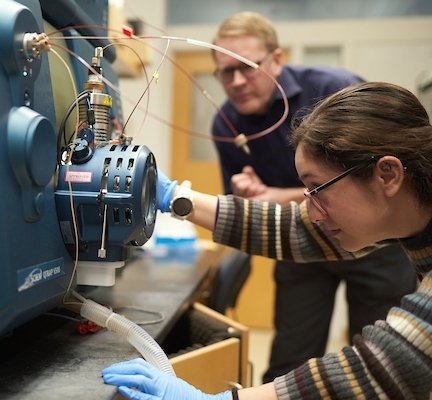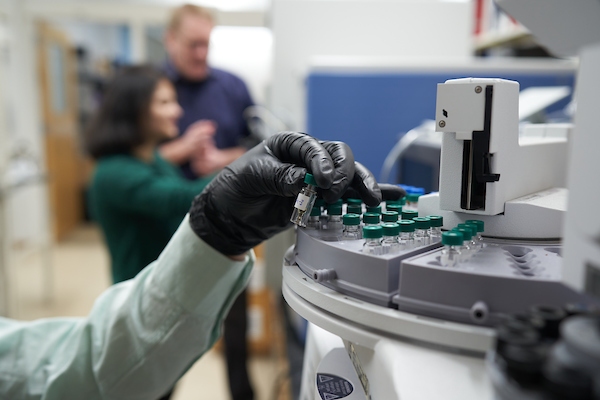Bioanalytical Chemistry Facility
Using state-of-the-art instrumentation, the Bioanalytical Chemistry Facility provides crucial proteomic, metabolomic, and ionomic data to scientists, advancing the mission of the Donald Danforth Plant Science Center. If genetic material is the blueprint of life, then proteins, metabolites, and elements are the machines and building blocks of life. Mass spectrometry allows scientists to study those machines and building blocks. A scientist trying to develop an improved crop will be able to know, by using mass spectrometry, if and how they have increased the crop’s nutrients or fitness. The Bioanalytical Chemistry Facility team lends their services to internal and external researchers and helps train scientists who are interested in developing their knowledge and skills in these essential fields.

Huang, H., Gehan, M. A., Huss, S. E., Alvarez, S., Lizarraga, C., Gruebbling, E. L., Gierer, J., Naldrett, M. J., Bindbeutel, R. K., Evans, B. S., Mockler, T. C., Nusinow, D., A. (2017) Cross-species complementation reveals conserved functions for EARLY FLOWERING 3 between monocots and dicots. Plant Direct. 1 (4); e00018.
Huang, H., Yoo, C. Y., Bindbeutel, R., Goldsworth, J., Tielking, A., Alvarez, S., Naldrett, M. J., Evans, B. S., Chen, M., Nusinow, D., A. (2016) PCH1 integrates circadian and light-signaling pathways to control photoperiod-responsive growth in Arabidopsis. eLife. 5; e13292.
Huang, H., Alvarez, S., Bindbeutel, R., Shen, Z., Naldrett, M. J., Evans, B. S., Briggs, S. P., Hicks, L. M., Kay, S. A., Nusinow, D. A. (2016) Identification of Evening Complex Associated Proteins in Arabidopsis by Affinity Purification and Mass Spectrometry. Molecular and Cellular Proteomics. 15 201-217.
Dey, S., North J. A., Sriam, J., Evans, B. S., Tabita, R. F. (2015) In Vivo Studies in Rhodospirillum rubrum Indicate that Ribulose-1,5-bisphosphate Carbxylase/Oxygenase (Rubisco) Catalyzes two Obligatory Required and Physiologically Significant Reactions for Distinct Carbon and Sulfur Metabolic Pathways. Journal of Biological Chemistry. 290 30658-30668.
Augustin, M. A., Ruzicka, D. R., Shukla, A. K., Augustin, J. M., Starks, C. M., O'Neil-Johnson, M., McKain, M. R., Evans, B. S., Barrett, M. D., Smithson, A., Wong, G. K., Deholos, M. K., Edger, P. P., Pires, C. J., Leebens-Mack., J. H., Mann, D. A., Kutchan, T. M., (2015) Elucidating steriod alkaloid biosynthesis in Veratrum californicum: production of verazine in Sf9 cells. The Plant Journal. 10.1111/tpj.12871
Lan, Z., Krosse, S. Achard, P., van Dam N.M., Bede, J.C. (2014) DELLA Proteins Modulate Arabidopsis Defences Induced in response to Caterpillar Herbivory. J Exp. Bot. 65(2) 571-583
Guggisberg A. M., Park, J. Edwards R. L., Kelley, M. L., Hodge D. M., Tolia N. H., Odom, A. R., A (2014) Sugar phosphatase Regulates the Methylerthitol Phosphate (MEP) Pathway in Malaria Parasites Nat. Commun. 5:4467
Kilgore, M.B., Augustin, M.M., Starks, C.M., O'Neil-Johnson, M. May, G.D., Crow, J.A., Kutchan, T.M. (2014) Cloning and Characterization of a Norbelladine 4'-O-Methyltransferase involved in the Biosynthesis of the Alzheimer's Drug Galanthamine in Narcissus sp. aff. pseudonarcissus. PLOS One 9 (7), e103223.
PubMed |
Alaganan, A., Fentress, S. J., Tang, K., Wang, Q., Sibley, L.D. (2014) Toxoplasma GRA7 effector increases turnover of immunity-related GTPases and contributes to acute virulence in the mouse. Proceedings of the National Academy of Science USA 111 (3), 1126-1131.
Shen, B., Sibley, L.D., (2014) Toxoplasma aldolase is required for metabolism but dispensable for host-cell invasion. Proceedings of the National Academy of Science USA 111 (9), 3567-3572.
Alvarez, S., Choudhury, S. R., Pandey, S., (2014) Comparative proteomics analysis of the ABA response of roots of drought-sensitive and drought-tolerant wheat varieties identifies proteomic signatures of drought adaptability. J. Proteome Research 13 (3) 1688-1701.
Allen, D. K., Evans, B. S., Libourel, I. G. (2014). Analysis of isotopic labeling in peptide fragments by tandem mass spectrometry. PLoS One 9(3):e91537
Papa L., Hahn M, Marsh, E. L., Evans, B.S., Germain, D. (2014). SOD2 to SOD1 Switch in Breast Cancer. Journal of Biological Chemistry, 289(9) 5412-5416.
Liu, D., Xiao, Y., Evans, B.S., Zhang, F. (2013). Negative feedback regulation of fatty acid production based on a malonyl-CoA sensor-actuator. ACS Synthetic Biology DOI: 10.1021/sb400158w
Reyes, L., Eiler-McManis, E., Rodrigues, P.H., Chadda, A.S., Wallet, S.M., Bélanger, M., Barrett, A.G., Alvarez, S., Akin, D., Dunn, W.A. Jr, Progulske-Fox, A. (2013). Deletion of Lipoprotein PG0717 in Porphyromonas gingivalis W83 Reduces Gingipain Activity and Alters Trafficking in and Response by Host Cells. PLoS One 8, e74230.
Schenck, C.A0, Nadella, V., Clay, S.L., Lindner, J., Abrams, Z., Wyatt, S.E. (2013) A proteomics approach identifies novel proteins involved in gravitropic signal transduction. Am J Bot 100, 194-202.
Collier, T.S., Diraviyam, K., Monsey, J., Shen, W., Sept, D., Bose, R. (2013). Carboxyl Group Footprinting Mass Spectrometry and Molecular Dynamics Identify Key Interactions in the HER2-HER3 Receptor Tyrosine Kinase Interface. J Biol Chem 288, 25254-25264.
Mutka, A.M., Fawley, S., Tsao, T., Kunkel, B.N. (2013).Auxin promotes susceptibility to Pseudomonas syringae via a mechanism independent of suppression of salicylic acid-mediated defenses. Plant J 74, 746-754.
Deng, X., Sun, F., Weerapana, E., Li, J., Jones, M., Ji, Q., Liang, H., Wang, C., Alvarez, S., Hicks, L.M., Peterson, S.N., Wu, M., Cravatt, B.F., He, C. (2013). Proteome-wide quantification and characterization of oxidation-sensitive cysteines in pathogenic bacteria. Cell Host Microbe 13, 358-370.
Allen, D.K. Young, J.D. (2013). Carbon and Nitrogen Provisions Alter the Metabolic Flux in Developing Soybean Embryos. Plant Physiol 161, 1458-1475.
Alvarez, S., Roy Choudhury, S., Hicks, L.M., Pandey, S. (2013). Quantitative Proteomics-Based Analysis Supports a Significant Role of GTG Proteins in Regulation of ABA Response in Arabidopsis Roots. J Proteome Res 12, 1487-1501.
Boyer AP, Collier TS, Vidavsky I, Bose R. (2013). Quantitative proteomics with siRNA screening identifies novel mechanisms of trastuzumab resistance in HER2 amplified breast cancers. Mol Cell Proteomics 12, 180-193.
Martyniuk, C.J., Alvarez, S. (2013). Proteome analysis of the fathead minnow (Pimephales promelas) reproductive testes. J Proteomics 79, 28-42.
Bashkin, J.K., Aston, K., Ramos, J.P., Koeller, K.J., Nanjunda R., He, G., Dupureur, C.M., Wilson W.D. (2012). Promoter scanning of the human COX-2 gene with 8-ring polyamides: Unexpected weakening of polyamide–DNA binding and selectivity by replacing an internal N-Me-pyrrole with β-alanine. Biochimie 95, 271-279.
Sun, F., Ding, Y., Ji, Q., Deng, X., Yi, C., Zhang, L., Alvarez, S., Hicks, L.M., Lan, L. He, C. (2012). Protein cysteine phosphorylation of SarA/MgrA family transcriptional regulators mediates bacterial virulence and antibiotic resistance. Proc Natl Acad Sci U S A 109, 15461-15466.
Sun, F., Liang, H., Kong, X., Xie, S., Cho, H., Deng, X., Ji, Q., Zhang, H., Alvarez, S., Hicks, L.M., Bae, T., Luo, C., Jiang, H., He, C. (2012). Quorum-sensing agr mediates bacterial oxidation response via an intramolecular disulfide redox switch in the response regulator AgrA. Proc Natl Acad Sci U S A 109, 9095-9100.
Martyniuk, C.J., Alvarez, S., Lo, B.P., Elphick, J.R., Marlatt, V.L. (2012). Hepatic Protein Expression Networks Associated with Masculinization in the Female Fathead Minnow (Pimephales promelas). J Proteome Res 11, 4147-4161.
Wang, H., Alvarez, S., Hicks, L.M. (2012). Comprehensive comparison of iTRAQ and label-free LC-based quantitative proteomics approaches using two Chlamydomonas reinhardtii strains of interest for biofuels engineering. J Proteome Res 11, 487-501.
Wang, H., Wang, S., Lu, Y., Alvarez, S., Hicks, L.M., Ge, X., Xia, Y. (2012). Proteomic analysis of early-responsive redox-sensitive proteins in Arabidopsis. J Proteome Res 11, 412-424.
Galant, A., Koester, R.P., Ainsworth, E.A., Hicks, L.M., Jez, J.M. (2012) From climate change to molecular response: Redox proteomics of ozone-induced responses in soybean. New Phytol 194, 220-229.
Hasnain, G., Waller, J.C., Alvarez, S., Ravilious, G.E., Jez, J.M., Hanson, A.D. (2012). Mutational analysis of YgfZ, a folate-dependent protein implicated in iron/sulphur cluster metabolism. FEMS Microbiol Lett 326, 168-172.
Waller, J.C., Ellens, K.W., Hasnain, G., Alvarez, S., Rocca, J.R., Hanson, A.D. (2012) Evidence that the folate-dependent proteins YgfZ and MnmEG have opposing effects on growth and on activity of the iron-sulfur enzyme MiaB. J Bacteriol 194, 362-367.
Martyniuk, C.J., Alvarez, S., Denslow, N.D. (2012) DIGE and iTRAQ as biomarker discovery tools in aquatic toxicology. Ecotoxicol Environ Saf 76, 3-10.
Waller, J.C., Ellens, K.W., Alvarez, S., Loizeau, K., Ravanel, S., Hanson, A.D. (2012). Mitochondrial and plastidial COG0354 proteins have folate-dependent functions in iron-sulphur cluster metabolism. J Exp Bot 63, 403-411.
Jiao, Y. J. Leebens-Mack, R. Ayyampalayam, J. Bowers, M. McKain, J. McNeal, M. Rolf, D. Ruzicka, E. Wafula, X. Wu, Y. Zhang, J. Wang, E.J. Carpenter, D. Soltis, P. Soltis, T.M. Kutchan, D. W. Stevenson, W. R. McCombie, G. Ka-Shu Wong, C. W. dePamphilis. (2012). Three times the fun: genome triplication associated with early diversification of the core eudicots. Genome Biol 13, R3.
Wang, Y., Yu, O. Synthetic scaffolds increased resveratrol biosynthesis in engineered yeast cells. (2012). J Biotechnol 157, 258-260.
Wang, Y., Yi, H., Wang, M., Yu, O., Jez, J. (2011) Structural and Kinetic Analysis of the Unnatural Fusion Protein 4-Coumaroyl-CoA Ligase::Stilbene Synthase. J Am Chem Soc133, 20684-20687.
Dalal, J.S., Stevens, S.M. Jr, Alvarez, S., Munoz, N., Kempler, K.E., Dosé, A.C., Burnside, B., Battelle, B.A. (2011). Mouse class III myosins: kinase activity and phosphorylation sites. J Neurochem 119,772-784.
Chen, H., Zhang, B., Hicks, L.M., Xiong, L. (2011) A nucleotide metabolite regulates stress-responsive gene expression and plant development. Plos One 6, e26661, 1-14.
Edwards, T.G., Koeller, K.J., Slomczynska, U., Fok, K., Helmus, M., Bashkin, J.K., Fisher, C. (2011). HPV episome levels are potently decreased by pyrrole-imidazole polyamides. Antiviral Res 91, 177-186.
Alvarez, S., Hicks, L.M., and Pandey, S. (2011). ABA-dependent and -independent G-protein signaling in Arabidopsis roots revealed through an iTRAQ proteomics approach. J Proteome Res 10, 3107-22.
| PubMed |
Alvarez, S., Galant, A., Jez, J.M., and Hicks, L.M. (2011). Redox-regulatory mechanisms induced by oxidative stress in Brassica juncea roots monitored by 2-DE proteomics. Proteomics 11, 1346-50.
| PubMed |
Alvarez, S., and Hicks, L.M. (2011). Survey in plant root proteomics. In Sustainable Agriculture and New Biotechnologies (CRC Press), pp. 215-56.
| Open Access – Full |
Song, C.X., Szulwach, K.E., Fu, Y., Dai, Q., Yi, C., Li, X., Li, Y., Chen, C.H., Zhang, W., Jian, X., Wang, J., Zhang, L., Looney, T.J., Zhang, B., Godley, L.A., Hicks, L.M., Lahn, B.T., Jin, P., and He, C. (2011). Selective chemical labeling reveals the genome-wide distribution of 5-hydroxymethylcytosine. Nat Biotechnol 29, 68-72.
| PubMed |
Chen, H., Saksa, K., Zhao, F., Qiu, J., and Xiong, L. (2010). Genetic analysis of pathway regulation for enhancing branched-chain amino acid biosynthesis in plants. Plant J 63, 573-583.
| PubMed |
Chen, Q., Westfall, C.S., Hicks, L.M., Wang, S., and Jez, J.M. (2010). Kinetic basis for the conjugation of auxin by a GH3 family indole acetic acid-amido synthetase. J Biol Chem 285,29780-29786.
| PubMed |
de Crecy-Lagard, V., Brochier-Armanet, C., Urbonavicius, J., Fernandez, B., Phillips, G., Lyons, B., Noma, A., Alvarez, S., Droogmans, L., Armengaud, J., and Grosjean, H. (2010). Biosynthesis of wyosine derivatives in tRNA: an ancient and highly diverse pathway in Archaea. Mol Biol Evol 27, 2062-2077.
| PubMed |
Ernst, L., Goodger, J.Q., Alvarez, S., Marsh, E.L., Berla, B., Lockhart, E., Jung, J., Li, P., Bohnert, H.J., and Schachtman, D.P. (2010). Sulphate as a xylem-borne chemical signal precedes the expression of ABA biosynthetic genes in maize roots. J Exp Bot 61, 3395-3405.
| PubMed |
Grobe, N., Lamshoft, M., Orth, R.G., Drager, B., Kutchan, T.M., Zenk, M.H., and Spiteller, M. (2010). Urinary excretion of morphine and biosynthetic precursors in mice. Proc Natl Acad Sci U S A 107, 8147-8152.
| PubMed |
Gutierrez-Gonzalez, J.J., Guttikonda, S.K., Tran, L.S., Aldrich, D.L., Zhong, R., Yu, O., Nguyen, H.T., and Sleper, D.A. (2010). Differential expression of isoflavone biosynthetic genes in soybean during water deficits. Plant Cell Physiol 51, 936-948.
| PubMed |
Gutierrez-Gonzalez, J.J., Wu, X., Gillman, J.D., Lee, J.D., Zhong, R., Yu, O., Shannon, G., Ellersieck, M., Nguyen, H.T., and Sleper, D.A. (2010). Intricate environment-modulated genetic networks control isoflavone accumulation in soybean seeds. BMC Plant Biol 10,105.
| PubMed |
Han, X., Lamshoft, M., Grobe, N., Ren, X., Fist, A.J., Kutchan, T.M., Spiteller, M., and Zenk, M.H. (2010). The biosynthesis of papaverine proceeds via (S)-reticuline. Phytochemistry 71,1305-1312.
| PubMed |
Li, H., Deng, Y., Wu, T., Subramanian, S., and Yu, O. (2010). Misexpression of miR482, miR1512, and miR1515 increases soybean nodulation. Plant Physiol 153, 1759-1770
| PubMed |
Marsh, E., Alvarez, S., Hicks, L.M., Barbazuk, W.B., Qiu, W., Kovacs, L., and Schachtman, D. (2010). Changes in protein abundance during powdery mildew infection of leaf tissues of Cabernet Sauvignon grapevine (Vitis vinifera L.). Proteomics 10, 2057-2064.
| PubMed |
Ning, J., Li, X., Hicks, L.M., and Xiong, L. (2010). A Raf-like MAPKKK gene DSM1 mediates drought resistance through reactive oxygen species scavenging in rice. Plant Physiol 152,876-890.
| PubMed |
Nomura, T., and Kutchan, T.M. (2010). Three new O-methyltransferases are sufficient for all O-methylation reactions of ipecac alkaloid biosynthesis in root culture of Psychotria ipecacuanha. J Biol Chem 285, 7722-7738.
| PubMed |
Pan, X., Welti, R., and Wang, X. (2010). Quantitative analysis of major plant hormones in crude plant extracts by high-performance liquid chromatography-mass spectrometry. Nat Protoc 5, 986-992.
| PubMed |
Waller, J.C., Alvarez, S., Naponelli, V., Lara-Nunez, A., Blaby, I.K., Da Silva, V., Ziemak, M.J., Vickers, T.J., Beverley, S.M., Edison, A.S., Rocca, J.R., Gregory, J.F., 3rd, de Crecy-Lagard, V., and Hanson, A.D. (2010). A role for tetrahydrofolates in the metabolism of iron-sulfur clusters in all domains of life. Proc Natl Acad Sci U S A 107, 10412-10417.
| PubMed |
Wu, B., Zhang, B., Feng, X., Rubens, J.R., Huang, R., Hicks, L.M., Pakrasi, H.B., and Tang, Y.J. (2010). Alternative isoleucine synthesis pathway in cyanobacterial species. Microbiology 156, 596-602.
| PubMed |
Yamaguchi, M., Valliyodan, B., Zhang, J., Lenoble, M.E., Yu, O., Rogers, E.E., Nguyen, H.T., and Sharp, R.E. (2010). Regulation of growth response to water stress in the soybean primary root. I. Proteomic analysis reveals region-specific regulation of phenylpropanoid metabolism and control of free iron in the elongation zone. Plant Cell Environ 33, 223-243.
| PubMed |
Zhang, B., Tolstikov, V., Turnbull, C., Hicks, L.M., and Fiehn, O. (2010). Divergent metabolome and proteome suggest functional independence of dual phloem transport systems in cucurbits. Proc Natl Acad Sci U S A 107, 13532-13537.
| PubMed |
Alvarez, S., Berla, B.M., Sheffield, J., Cahoon, R.E., Jez, J.M., and Hicks, L.M. (2009). Comprehensive analysis of the Brassica juncea root proteome in response to cadmium exposure by complementary proteomic approaches. Proteomics 9, 2419-2431.
| PubMed |
Alvarez, S., Wilson, G.H., and Chen, S. (2009). Determination of in vivo disulfide-bonded proteins in Arabidopsis. J Chromatogr B Analyt Technol Biomed Life Sci 877, 101-104.
| PubMed |
Alvarez, S., Zhu, M., and Chen, S. (2009). Proteomics of Arabidopsis redox proteins in response to methyl jasmonate. J Proteomics 73, 30-40.
| PubMed |
Beaudoin, F., Wu, X., Li, F., Haslam, R.P., Markham, J.E., Zheng, H., Napier, J.A., and Kunst, L. (2009). Functional characterization of the Arabidopsis b-ketoacyl-coenzyme A reductase candidates of the fatty acid elongase. Plant Physiol 150, 1174-1191.
| PubMed |
Chen, H., and Xiong, L. (2009). Enhancement of vitamin B(6) levels in seeds through metabolic engineering. Plant Biotechnol J 7, 673-681.
| PubMed |
Chen, Q., Zhang, B., Hicks, L.M., Wang, S., and Jez, J.M. (2009). A liquid chromatography-tandem mass spectrometry-based assay for indole-3-acetic acid-amido synthetase. Anal Biochem 390, 149-154.
| PubMed |
Feng, X., Mouttaki, H., Lin, L., Huang, R., Wu, B., Hemme, C.L., He, Z., Zhang, B., Hicks, L.M., Xu, J., Zhou, J., and Tang, Y.J. (2009). Characterization of the central metabolic pathways in Thermoanaerobacter sp. strain X514 via isotopomer-assisted metabolite analysis. Appl Environ Microbiol 75, 5001-5008.
| PubMed |
Gesell, A., Rolf, M., Ziegler, J., Diaz Chavez, M.L., Huang, F.C., and Kutchan, T.M. (2009). CYP719B1 is salutaridine synthase, the C-C phenol-coupling enzyme of morphine biosynthesis in opium poppy. J Biol Chem 284, 24432-24442.
| PubMed |
Grobe, N., Zhang, B., Fisinger, U., Kutchan, T.M., Zenk, M.H., and Guengerich, F.P. (2009). Mammalian cytochrome P450 enzymes catalyze the phenol-coupling step in endogenous morphine biosynthesis. J Biol Chem 284, 24425-24431.
| PubMed |
Gutierrez-Gonzalez, J.J., Wu, X., Zhang, J., Lee, J.D., Ellersieck, M., Shannon, J.G., Yu, O., Nguyen, H.T., and Sleper, D.A. (2009). Genetic control of soybean seed isoflavone content: importance of statistical model and epistasis in complex traits. Theor Appl Genet 119, 1069-1083.
| PubMed |
Kavazis, A.N., Alvarez, S., Talbert, E., Lee, Y., and Powers, S.K. (2009). Exercise training induces a cardioprotective phenotype and alterations in cardiac subsarcolemmal and intermyofibrillar mitochondrial proteins. Am J Physiol Heart Circ Physiol 297, H144-152.
| PubMed |
Kempe, K., Higashi, Y., Frick, S., Sabarna, K., and Kutchan, T.M. (2009). RNAi suppression of the morphine biosynthetic gene salAT and evidence of association of pathway enzymes. Phytochemistry 70, 579-589.
| PubMed |
Kumaran, S., Yi, H., Krishnan, H.B., and Jez, J.M. (2009). Assembly of the cysteine synthase complex and the regulatory role of protein-protein interactions. J Biol Chem 284,10268-10275.
| PubMed |
Martyniuk, C.J., Alvarez, S., McClung, S., Villeneuve, D.L., Ankley, G.T., and Denslow, N.D. (2009). Quantitative proteomic profiles of androgen receptor signaling in the liver of fathead minnows (Pimephales promelas). J Proteome Res 8, 2186-2200.
| PubMed |
Michaelson, L.V., Zauner, S., Markham, J.E., Haslam, R.P., Desikan, R., Mugford, S., Albrecht, S., Warnecke, D., Sperling, P., Heinz, E., and Napier, J.A. (2009). Functional characterization of a higher plant sphingolipid Delta4-desaturase: defining the role of sphingosine and sphingosine-1-phosphate in Arabidopsis. Plant Physiol 149, 487-498.
| PubMed |
Pan, X., and Wang, X. (2009). Profiling of plant hormones by mass spectrometry. J Chromatogr B Analyt Technol Biomed Life Sci 877, 2806-2813.
| PubMed |
Reyes, L., Alvarez, S., Allam, A., Reinhard, M., and Brown, M.B. (2009). Complicated urinary tract infection is associated with uroepithelial expression of proinflammatory protein S100A8. Infect Immun 77, 4265-4274.
| PubMed |
Subramanian, S., Cho, U.H., Keyes, C., and Yu, O. (2009). Distinct changes in soybean xylem sap proteome in response to pathogenic and symbiotic microbe interactions. BMC Plant Biol 9, 119.
| PubMed |
Zhang, J., Subramanian, S., Stacey, G., and Yu, O. (2009). Flavones and flavonols play distinct critical roles during nodulation of Medicago truncatula by Sinorhizobium meliloti. Plant J 57, 171-183.
| PubMed |
Alvarez, S., Marsh, E.L., Schroeder, S.G., and Schachtman, D.P. (2008). Metabolomic and proteomic changes in the xylem sap of maize under drought. Plant Cell Environ 31, 325-340.
| PubMed |
Bach, L., Michaelson, L.V., Haslam, R., Bellec, Y., Gissot, L., Marion, J., Da Costa, M., Boutin, J.P., Miquel, M., Tellier, F., Domergue, F., Markham, J.E., Beaudoin, F., Napier, J.A., and Faure, J.D. (2008). The very-long-chain hydroxy fatty acyl-CoA dehydratase PASTICCINO2 is essential and limiting for plant development. Proc Natl Acad Sci U S A 105,14727-14731.
| PubMed |
Chen, H., Hu, J., Chen, P.R., Lan, L., Li, Z., Hicks, L.M., Dinner, A.R., and He, C. (2008). ThePseudomonas aeruginosa multidrug efflux regulator MexR uses an oxidation-sensing mechanism. Proc Natl Acad Sci U S A 105, 13586-13591.
| PubMed |
Chen, M., Markham, J.E., Dietrich, C.R., Jaworski, J.G., and Cahoon, E.B. (2008). Sphingolipid long-chain base hydroxylation is important for growth and regulation of sphingolipid content and composition in Arabidopsis. Plant Cell 20, 1862-1878.
| PubMed |
Hong, Y., Pan, X., Welti, R., and Wang, X. (2008). Phospholipase Da3 is involved in the hyperosmotic response in Arabidopsis. Plant Cell 20, 803-816.
| PubMed |
Jindaprasert, A., Springob, K., Schmidt, J., De-Eknamkul, W., and Kutchan, T.M. (2008). Pyrone polyketides synthesized by a type III polyketide synthase from Drosophyllum lusitanicum. Phytochemistry 69, 3043-3053.
| PubMed |
Kopycki, J.G., Stubbs, M.T., Brandt, W., Hagemann, M., Porzel, A., Schmidt, J., Schliemann, W., Zenk, M.H., and Vogt, T. (2008). Functional and structural characterization of a cation-dependent O-methyltransferase from the cyanobacterium Synechocystis sp. strain PCC 6803. J Biol Chem 283, 20888-20896.
| PubMed |
Nagamune, K., Hicks, L.M., Fux, B., Brossier, F., Chini, E.N., and Sibley, L.D. (2008). Abscisic acid controls calcium-dependent egress and development in Toxoplasma gondii. Nature 451, 207-210.
| PubMed |
Nomura, T., Quesada, A.L., and Kutchan, T.M. (2008). The new beta-D-glucosidase in terpenoid-isoquinoline alkaloid biosynthesis in Psychotria ipecacuanha. J Biol Chem 283,34650-34659.
| PubMed |
Pan, X., Welti, R., and Wang, X. (2008). Simultaneous quantification of major phytohormones and related compounds in crude plant extracts by liquid chromatography-electrospray tandem mass spectrometry. Phytochemistry 69, 1773-1781.
| PubMed |
Phillips, G., El Yacoubi, B., Lyons, B., Alvarez, S., Iwata-Reuyl, D., and de Crecy-Lagard, V. (2008). Biosynthesis of 7-deazaguanosine-modified tRNA nucleosides: a new role for GTP cyclohydrolase I. J Bacteriol 190, 7876-7884.
| PubMed |
Sarma, A.D., Oehrle, N.W., and Emerich, D.W. (2008). Plant protein isolation and stabilization for enhanced resolution of two-dimensional polyacrylamide gel electrophoresis. Anal Biochem 379, 192-195.
| PubMed |
Schmidt, M.A., and Herman, E.M. (2008). Proteome rebalancing in soybean seeds can be exploited to enhance foreign protein accumulation. Plant Biotechnol J 6, 832-842.
| PubMed |
Schmidt, M.A., and Herman, E.M. (2008). Suppression of soybean oleosin produces micro-oil bodies that aggregate into oil body/ER complexes. Mol Plant 1, 910-924.
| PubMed |
Schroeder, A.C., Kumaran, S., Hicks, L.M., Cahoon, R.E., Halls, C., Yu, O., and Jez, J.M.(2008). Contributions of conserved serine and tyrosine residues to catalysis, ligand binding, and cofactor processing in the active site of tyrosine ammonia lyase. Phytochemistry 69,1496-1506.
| PubMed |
Wang, W., Yang, X., Tangchaiburana, S., Ndeh, R., Markham, J.E., Tsegaye, Y., Dunn, T.M., Wang, G.L., Bellizzi, M., Parsons, J.F., Morrissey, D., Bravo, J.E., Lynch, D.V., and Xiao, S.(2008). An inositolphosphorylceramide synthase is involved in regulation of plant programmed cell death associated with defense in Arabidopsis. Plant Cell 20, 3163-3179.
| PubMed |
Brendza, K.M., Haakenson, W., Cahoon, R.E., Hicks, L.M., Palavalli, L.H., Chiapelli, B.J., McLaird, M., McCarter, J.P., Williams, D.J., Hresko, M.C., and Jez, J.M. (2007). Phosphoethanolamine N-methyltransferase (PMT-1) catalyses the first reaction of a new pathway for phosphocholine biosynthesis in Caenorhabditis elegans. Biochem J 404, 439-448.
| PubMed |
Earley, K.W., Shook, M.S., Brower-Toland, B., Hicks, L., and Pikaard, C.S. (2007). In vitro specificities of Arabidopsis co-activator histone acetyltransferases: implications for histone hyperacetylation in gene activation. Plant J 52, 615-626.
| PubMed |
Graham, T.L., Graham, M.Y., Subramanian, S., and Yu, O. (2007). RNAi silencing of genes for elicitation or biosynthesis of 5-deoxyisoflavonoids suppresses race-specific resistance and hypersensitive cell death in Phytophthora sojae infected tissues. Plant Physiol 144, 728-740.
| PubMed |
Hicks, L.M., Cahoon, R.E., Bonner, E.R., Rivard, R.S., Sheffield, J., and Jez, J.M. (2007). Thiol-based regulation of redox-active glutamate-cysteine ligase from Arabidopsis thaliana. Plant Cell 19, 2653-2661.
| PubMed |
Jez, J.M., Schachtman, D.P., Berg, R.H., Taylor, C.G., Chen, S., Hicks, L.M., Jaworski, J.G., Smith, T.J., Nielsen, E., and Pikaard, C.S. (2007). Developing a new interdisciplinary lab course for undergraduate and graduate students: plant cells and proteins. Biochem Mol Biol Educ 35, 410-415
Katpally, U., and Smith, T.J. (2007). Pocket factors are unlikely to play a major role in the life cycle of human rhinovirus. J Virol 81, 6307-6315.
| PubMed |
Livingstone, D., Beilinson, V., Kalyaeva, M., Schmidt, M.A., Herman, E.M., and Nielsen, N.C. (2007). Reduction of protease inhibitor activity by expression of a mutant Bowman-Birk gene in soybean seed. Plant Mol Biol 64, 397-408.
| PubMed |
Markham, J.E., and Jaworski, J.G. (2007). Rapid measurement of sphingolipids fromArabidopsis thaliana by reversed-phase high-performance liquid chromatography coupled to electrospray ionization tandem mass spectrometry. Rapid Commun Mass Spectrom 21,1304-1314.
| PubMed |
Moravec, T., Schmidt, M.A., Herman, E.M., and Woodford-Thomas, T. (2007). Production ofEscherichia coli heat labile toxin (LT) B subunit in soybean seed and analysis of its immunogenicity as an oral vaccine. Vaccine 25, 1647-1657.
| PubMed |
Shin, R., Alvarez, S., Burch, A.Y., Jez, J.M., and Schachtman, D.P. (2007). Phosphoproteomic identification of targets of the Arabidopsis sucrose nonfermenting-like kinase SnRK2.8 reveals a connection to metabolic processes. Proc Natl Acad Sci U S A 104,6460-6465.
| PubMed |
Tsegaye, Y., Richardson, C.G., Bravo, J.E., Mulcahy, B.J., Lynch, D.V., Markham, J.E., Jaworski, J.G., Chen, M., Cahoon, E.B., and Dunn, T.M. (2007). Arabidopsis mutants lacking long chain base phosphate lyase are fumonisin-sensitive and accumulate trihydroxy-18:1 long chain base phosphate. J Biol Chem 282, 28195-28206.
| PubMed | Request Copy |
Yang, W., Devaiah, S.P., Pan, X., Isaac, G., Welti, R., and Wang, X. (2007). AtPLAI is an acyl hydrolase involved in basal jasmonic acid production and Arabidopsis resistance to Botrytis cinerea. J Biol Chem 282, 18116-18128.
| PubMed |
Zhang, J., Subramanian, S., Zhang, Y., and Yu, O. (2007). Flavone synthases fromMedicago truncatula are flavanone-2-hydroxylases and are important for nodulation. Plant Physiol 144, 741-751.
| PubMed |
Zhu, J., Alvarez, S., Marsh, E.L., Lenoble, M.E., Cho, I.J., Sivaguru, M., Chen, S., Nguyen, H.T., Wu, Y., Schachtman, D.P., and Sharp, R.E. (2007). Cell wall proteome in the maize primary root elongation zone. II. Region-specific changes in water soluble and lightly ionically bound proteins under water deficit. Plant Physiol 145, 1533-1548.
| PubMed |
Alvarez, S., Goodger, J.Q., Marsh, E.L., Chen, S., Asirvatham, V.S., and Schachtman, D.P.(2006). Characterization of the maize xylem sap proteome. J Proteome Res 5, 963-972.
| PubMed |
Chen, S. (2006). Rapid protein identification using direct infusion nanoelectrospray ionization mass spectrometry. Proteomics 6, 16-25.
| PubMed |
Herman, E.M., Rotter, K., Premakumar, R., Elwinger, G., Bae, H., Ehler-King, L., Chen, S., and Livingston, D.P., 3rd. (2006). Additional freeze hardiness in wheat acquired by exposure to -3 degreesC is associated with extensive physiological, morphological, and molecular changes. J Exp Bot 57, 3601-3618.
| PubMed |
Joseph, L.M., Hymowitz, T., Schmidt, M.A., and Herman, E.M. (2006). Evaluation of glycine germplasm for nulls of the immunodominant allergen p34/Gly m BD 30k. Crop Sci 46, 1755-1763
Markham, J.E., Li, J., Cahoon, E.B., and Jaworski, J.G. (2006). Separation and identification of major plant sphingolipid classes from leaves. J Biol Chem 281, 22684-22694.
| PubMed |
Palavalli, L.H., Brendza, K.M., Haakenson, W., Cahoon, R.E., McLaird, M., Hicks, L.M., McCarter, J.P., Williams, D.J., Hresko, M.C., and Jez, J.M. (2006). Defining the role of phosphomethylethanolamine N-methyltransferase from Caenorhabditis elegans in phosphocholine biosynthesis by biochemical and kinetic analysis. Biochemistry 45, 6056-6065.
| PubMed |
Sheffield, J., Taylor, N., Fauquet, C., and Chen, S. (2006). The cassava (Manihot esculenta Crantz) root proteome: protein identification and differential expression. Proteomics 6, 1588-1598.
| PubMed |
Subramanian, S., Stacey, G., and Yu, O. (2006). Endogenous isoflavones are essential for the establishment of symbiosis between soybean and Bradyrhizobium japonicum. Plant J48, 261-273.
| PubMed |
Zhang, Y., Li, S.Z., Li, J., Pan, X., Cahoon, R.E., Jaworski, J.G., Wang, X., Jez, J.M., Chen, F., and Yu, O. (2006). Using unnatural protein fusions to engineer resveratrol biosynthesis in yeast and Mammalian cells. J Am Chem Soc 128, 13030-13031.
| PubMed |
Zhu, J., Chen, S., Alvarez, S., Asirvatham, V.S., Schachtman, D.P., Wu, Y., and Sharp, R.E.(2006). Cell wall proteome in the maize primary root elongation zone. I. Extraction and identification of water-soluble and lightly ionically bound proteins. Plant Physiol 140, 311-325.
| PubMed |
Bonner, E.R., Cahoon, R.E., Knapke, S.M., and Jez, J.M. (2005). Molecular basis of cysteine biosynthesis in plants: structural and functional analysis of O-acetylserine sulfhydrylase from Arabidopsis thaliana. J Biol Chem 280, 38803-38813.
| PubMed |
If data from our instruments results in a publication, please cite us using the appropriate citation below. Funding agencies require us to accurately report this data and it helps us in attracting and maintaining funding to provide top-class facilities.
6500 QTRAP Citation
“This material is based upon work supported by the National Science Foundation under Grant No. DBI-1427621 for acquisition of the QTRAP LC-MS/MS.”
LTQ-Velos Pro Orbitrap Citation
“This material is based upon work supported by the National Science Foundation under Grant No. DBI-0922879 for acquisition of the LTQ-Velos Pro Orbitrap LC-MS/MS.”
Orbitrap Fusion Lumos Citation
“This material is based upon work supported by the National Science Foundation under Grant No. DBI-1827534 for acquisition of the Orbitrap Fusion Lumos LC-MS/MS.”
Data Retention Policy
The Danforth Center Bioanalytical Chemistry Facility will retain all raw and processed data for a 12-month period after data posting. We encourage users to download their data and archive appropriately. These data are included as .zip files in the Results page of your order. There are a number of free, online data repositories that we recommend for archiving of mass spectrometry data. These repositories accept data and will keep them as private archives until such time as the data are published or the depositor decides to make them public. This publicly accessible archiving is in accordance with a number of scientific journals and is now widely accepted policy. For proteomics datasets we recommend PRIDE or ProteomeXchange. For small molecule datasets we recommend Metabolomics Workbench, MetaboLights or MetabolomeXchange.
Core facilities must charge for services rendered according to cost accounting practices set up at each institution. Charging for services does not preclude authorship on manuscripts provided the Core laboratory individual has contributed to the research in a substantial way. If authorship is anticipated, it is preferably established at the beginning of the project so that both the customer and the Core researcher are cognizant of each other’s criteria.
Important reasons for acknowledging contributions from core facilities in publications, by co-authorship or by formal mention in the acknowledgments section, include:
- Core facility personnel are scientists. When they make a substantial intellectual and/or experimental contribution to a publication they deserve to be acknowledged just as any other co-author.
- The existence of core facilities depends in part on proper acknowledgment in publications. This is an important metric of the value of most core facilities. Proper acknowledgment of core facilities enables them to obtain financial and other support so that they may continue to provide their essential services in the best ways possible. It also helps core personnel to advance in their careers, adding to the overall health of the core facility.
Activities for which authorship are recommended:
- Author should make substantive contributions to the project
- Conception, design of project, critical input, or original ideas
- Acquisition of data, analysis and interpretation, beyond routine practices
- Draft the article or revise it critically for intellectual content
- Write a portion of the paper (not just materials and methods section)
- Intellectual contribution
- Final authority for the approval of article
- Each author should have participated enough to accept responsibility for the content of the manuscript
The following activities do not represent intellectual contributions to a project and would not constitute authorship:
- Providing funding (department chair who has no intellectual input)
- Collection of data (technical skill but not involved in interpretation of data)
- General supervision of research group, but no intellectual input into the project
All contributors that do not meet the criteria of authorship should be recognized in the acknowledgments section, for example:
- Paid technical help
- Writing assistance
- Financial and material support
- Scientific advice
Two examples are pertinent: (from Robert A. Day: How to Write and Publish a Scientific Paper, 5th Edition)
Example 1: Scientist A designs the experiments, and tells Technician B exactly how to do the experiments. If the experiments work and a new discovery is made and a manuscript results, Scientist A is the sole author and Technician B is recognized in the acknowledgments section.
Example 2: Scientist A designs the experiments, Technician B carries them out but they do not work. Technician B suggests some changes to the protocol, the experiments then work because of the changes and a discovery results. Scientist A and Technician B are now both authors.
BCF Equipment
- The Orbitrap Fusion Lumos Tribrid MS has a resolving power of up to 500,000 FWHM at 200 m/z and a scan rate of up to 40 Hz
- Mass accuracy of < 3 ppm with external calibration
- Multiple fragmentation techniques, including CID, HCD, and ETD provides improved sequence coverage and identification
- Parallel MS and MSn analysis
- Higher pressure capability of the RSLCnano platform allows the use of longer columns and/or columns packed with smaller particles for higher resolution separations of complex (digested) protein samples
- Temperature-controlled column compartment for maintaining retention time reproducibility
- The Q Exactive Orbitrap MS has a resolving power of up to 140,000 FWHM at 200 m/z and a scan rate of up to 12 Hz
- Mass accuracy of < 5 ppm with external calibration
- HCD fragmentation for MS2
- Ultimate 3000 platform allows for flowrates from 2.5 µL/min to 2 mL/min
- Temperature-controlled column compartment for maintaining retention time reproducibility
- The TSQ Altis Triple Quadrupole MS has a resolution of up to 0.2 Da (FWHM)
- Scan rate of up to 1000 Da/sec
- Mass range of 5-2000 m/z
- Capable of ultrafast selected reaction monitoring (SRM)
- SelexION feature allows resolution of isobaric species using differential mobility spectrometry
- Up to 100 fold more sensitive than previous generation LC-MS/MS systems
- Enables high-sensitivity full-scan MS, MS/MS, and MS3 with high-selectivity from true triple quadrupole precursor ion (PI) and neutral loss (NL) scans.
- Perform multiple reaction monitoring (MRM) for quantitation using high-sensitivity triple quadrupole.
- Identify, characterize, and quantitate metabolites quickly and easily.
- Inert ion source-now programmable up to 350˚C
- Triple-Axis HED-EM Detector
- ESI Chip of the TriVersa consists of an array of 400 nanoelectrospray emitters with different inner diameters allowing for flow rates of 20 to 300 nL/min.
- Nozzles on the ESI Chip provide a long, stable spray, and in infusion mode, eliminate sample-to-sample carryover.
- TriVersa can be used for Chip-based infusion or LC/MS fraction collection
- TriVersa can be coupled to any conventional HPLC system for MS analysis
- A powerful database search engine
- Integrates all the proven methods of database searching
- Peptide Fingerprint, Sequence Query and MS/MS Ion Search
- Total flexibility in chemical/post-translational modifications
- MS/MS analysis & visualization software
- See proteins identified across multiple samples.
- Combine Sequest and Mascot scores for increased confidence.
- Get more detailed and accurate information from your MS/MS experiments
- The TissueLyser II is a reciprocating ball mill capable of processing 48 samples at a time in 1.5 or 2. mL Eppendorf tubes. Features memory settings for variable frequency and time programs. The sample holders can be pre-cooled to cryogenic temperatures for heat sensitive samples.
BCF Services
We accept samples prepared from customers but they have to meet some requirements. Please read recommendations below:
For HPLC protein and peptide purification:
- Samples submitted should be free of non-volatile buffer components if possible.
- For special needs, columns and separation methods should be provided by users.
For 2-D gel protein separation:
- For analytical purposes, as little as 50 µg protein is needed. For preparative purposes, more than 1 mg protein can be loaded. The amount of sample depends on the complexity and the purpose of research.
- Salts, residue buffer components, and other charged small molecules should be removed. The tolerance for salts is 10 mM.
- Use zwitterionic or non-ionic detergents to increase protein solubility.
- Samples rich in nucleic acids should be treated with protease-free DNase/Rnase.
- Polysaccharides, lipids, and phenolic compounds should all be removed if possible.
For mass spectrometry:
- Use volatile, salt-free solvents such as methanol and acetonitrile.
- Salts normally form adduct peaks which suppress the molecular ion signal. Exchange sodium and potassium for ammonium when possible. Avoid phosphate buffers, use minimum concentrations of ammonium bicarbonate or ammonium acetate to control pH
- Avoid glycerol, DMSO, SDS, urea and guanidine. If detergents must be used, octyl glucoside (0.1%) is the best choice.
The acquired data can be submitted to database searching and protein identification using Proteome Discoverer v2.4 or MASCOT v2.5 database searching engine. We also have additional bioinformatics tools for data conversion (MASCOT Distiller) and for protein reporting (Scaffold v4.8, Proteome Software).
Many proteins can be post-translationally modified. These modifications can be dynamic with time, cell cycle state or in response to stresses. PTMs may regulate enzymatic activity, binding properties or target proteins for degradation or to specific cellular compartments. It is for this reason that many biologists are interested in characterizing the post-translational modifications present in their protein or proteome samples.
The PMSF offers several services that can assist in PTM analysis.
We offer label-based quantitative proteomics using DIGE (2D-gel based), 4-plex/7-plex-iTRAQ and 6-plex TMT (LC based), as well as label free (LC-based) quantitative proteomics for smaller size projects.
- iTRAQ (AB Sciex) is a non-gel based technique used to identify and quantify proteins from different sources in one single experiment. It uses isotope coded covalent tags. The method is based on the covalent labeling of the N-terminus and side chain amines of peptides from protein digests with isotopically labeled tags. The facility is set up to run the 4-plex (114, 155, 116 and 117 labels) or 7-plex (113, 114, 115, 166, 117, 118 and 119 labels) iTRAQ which can be used to label all peptides from up to 4 or 7 different samples/treatments. After labeling, the samples are pooled and fractionated by OFFGEL isoelectric focusing (Agilent). Each fraction is then analyzed by LC-MS/MS. A database search is then performed using Mascot Server v2.4 (Matrix Science). The relative abundances of the proteins in a sample are calculated using ProteoIQ (PREMIER Biosoft). The fragmentation of the attached tag generates a low mass reporter ion that can be used to relative quantitation of the peptides and the proteins from which they originated.
- TMT (Thermo-Fisher Scientific) enables labeling of proteins extracted from cells and tissues for relative quantitation and uses LC-based separation followed by tandem mass spectrometry. The labeling chemistry of the 6-plex tags (126, 127, 128, 129, 130 and 131) is the same as for iTRAQ labeling. The reagents label peptides prepared from up to 6 samples. The following steps to the identification and quantification of the proteins present in the samples are the same as previously described for iTRAQ.
- Label free quantitation is LC-based.We offer quantitation based on precursor ion intensity for relative quantitation of proteins between samples. Because it does not use a stable isotope tag, the comparison between samples is limited to small experiments of 2 samples including a minimum of 3 biological/technical replicates to reduce the experimental variation. Pre-fractionation using OFFGEL (Agilent) is also recommended to increase proteome coverage. The data acquired is analyzed using the Progenesis LC-MS (NonLinear Dynamics) for chromatogram alignment and protein quantitation. Protein identification is done using Mascot Server v2.4 (Matrix Science).
The facility is equipped with TSQ Altis (Thermo Scientific) and 6500 QTRAP (AB Sciex) LC/MS/MS systems, which are ideal for targeted small molecule quantitation. The following targeted methods are offered as full service:
- Acidic Plant Hormone Analysis
Targeted analysis and quantitation of the following acidic plant hormones: Jasmonic acid (JA), Salicyclic acid (SA), Abscisic acid (ABA), Indole-3-acetic acid (IAA), JA-Ile (jasmonoyl-isoleucine), OPDA (12-oxo-phytodienoic acid), IAA-Asp (Indole-3-acetyl-aspartic acid), cis and trans zeatin, dihydrozeatin, and zeatin riboside. The hormone extraction from plant tissues is performed by facility staff as it requires the spiking of deuterium-labeled internal standards at the beginning of the sample preparation. For more information, please see the Plant Hormone PDF (under PMFS Protocols). - Amino Acid Analysis
We can perform either free amino acids (client extracted) or HCl hydrolysis (usually from tissue). We recommend samples be run in triplicate for appropriate statistical analysis. For more information, please see the AAA PDF (under PMFS Protocols). - Isoprenoid Biosynthesis Intermediates
Quantification of 5 of the intermediates of the Non-mevalonate/methylerythritol/deoxyxylulose isoprenoid biosynthesis (MEP/DXP) pathway (DXP, MEP, CDP-ME, CDP-MEP* and cMEPP). The sample preparation is performed in house and samples are analyzed using a 20 minute run. For more information, please see this publication.
We can extend our current methods to meet your needs or develop new methods for your particular projects. Please contact us for details.
The facility is equipped with Q Exactive Orbitrap and Orbitrap Fusion Lumos Tribrid mass spectrometers that can provide HR-MS/MS data for untargeted metabolomics projects.
This data can be analyzed using Compound Discoverer (Thermo Scientific) to look for database hits for identification of metabolites of interest. This unbiased approach can provide insight into systems when the underlying metabolomic processes are not fully understood.

BCF Fees
Please email BCF@danforthcenter.org to inquire about pricing.
Meet the Team

Russell Williams
Core Facility Director, BCF
314.587.1461
rwilliams@danforthcenter.org

Katia Gutierrez
Research Technician I
kgutierrez@danforthcenter.org

Melissa Jurkowski
Research Assistant
mjurkowski@danforthcenter.org

Michael Wei
Staff Scientist
mwei@danforthcenter.org
Contact Us
Phone
314.587.1461
Donald Danforth Plant Science Center
Proteomics & Mass Spectrometry
975 North Warson Road
St. Louis, MO 63132

Plant Growth
